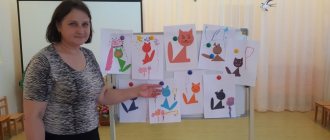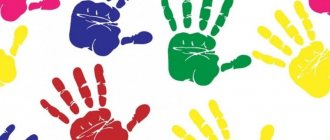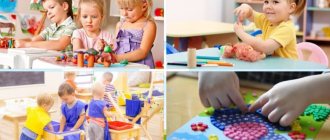Sand therapy for children makes a significant contribution to the development of cognitive and creative abilities, speech, fine motor skills and tactile sensitivity. Sand helps a child get rid of negative emotions, relax and relieve stress. Joint play and creativity with parents have a beneficial effect on family relationships.
Techniques for drawing on a light tablet
1. pouring
. The sand is clenched into a fist and passed through the fingers. The technique is suitable for drawing lines.
2. Pinch
. The child connects the thumb, middle and index fingers, picks up a little sand and scatters it. The method allows you to convey tones and shadows.
3. Palm
. With an open palm, the child levels the layer of sand, erases the drawing, and leaves prints.
4. Fist
. The child squeezes his palm and forms a spot on the sand layer with the back of his hand.
5. Finger painting
. This method allows you to create lines of different thicknesses and points, achieving image clarity. As a rule, children begin to work with their index finger. Encourage your child to use all fingers on both hands and make parallel movements. This stimulates brain activity.
6. Drawing with tools
. Drawings, lines, and ornaments are created using a comb. Pay your child's attention to how the pattern changes depending on the pressure applied.
Games and art therapy exercises
Sandy beach
Invite your child to imagine that he is on the seashore on a sunny day, grains of sand tickle his palms, he can hear the splash of waves, and there is silence all around. Let the baby touch the sand, take a handful while taking a deep breath and squeeze his fingers as hard as possible. As you exhale, the child gradually pours out the sand and relaxes.
Target:
development of tactile sensitivity, regulation of muscle tension, development of self-control.
Paths
Start with simple straight stripes. Then move on to broken, broken and wavy lines. Invite your child to draw a path home for their favorite fairy-tale character.
Target:
improvement of coordination of movements and orientation in space.
Additional exercises: “Rain” - for practicing drawing vertical lines. “Ladders” - this exercise teaches you to combine vertical and horizontal lines.
Sand doodles
Two people are playing. One person closes his eyes while the other person draws a simple doodle in the sand. Then the first participant opens his eyes and can complete the scribble, turning it into some kind of understandable image. Then the players change roles.
Target:
development of imagination.
My favorite toy
A child draws his favorite toy with sand and then describes it in words without naming it. The adult or other children present must guess what thing is being talked about.
Target:
development of coherent speech and communication skills, formation of the ability to understand each other.
Animal portraits
Invite your child to draw with sand animals expressing joy, delight, anger, fear, sadness, surprise. Ask the little artist to tell us who he depicted, what mood this character is in, what feelings he is experiencing, what happened to him and why, how you can help him.
Target:
acquaintance with basic emotions, learning to determine the emotional state, help in understanding one’s own feelings, development of coherent speech.
Puzzles
Make a wish for any object: an animal, a bird, a plant, a piece of furniture, a toy. Invite your child to guess what you have in mind based on the clues. If a pear is wished for, it can be described as follows: it is a fruit; grows on a tree; looks like a light bulb. The child must draw his answer on the light table.
You can make guesses and describe events. For example, celebrating the New Year, going to visit. Change roles so that the child has the opportunity to come up with riddles himself.
Target:
development of logical and associative thinking, imagination.
Gardener
“Turn” the light table into an orchard and invite your child to plant it with different plants. The kid makes drawings and tells what grows where. Ask him to describe fruits, vegetables and berries by color, shape and taste. Try to draw together the trees and shrubs on which fruits are ripening.
Target:
acquaintance with the world around us and broadening our horizons, developing thinking and coherent speech.
Complete the picture
Using sand on a light table, draw circles, squares, triangles and ask your child to complete the picture so that you get a sun, a ball, a house, a flag, a piece of cheese.
Target:
development of figurative memory and imagination.
Dressy socks
Children play in pairs or with an adult. The participants’ task is to draw two socks so that they make a set. To do this, you need to agree on what pattern will be on the socks, and try to depict it the same way.
Target:
developing the ability to work in a team, negotiate and come to a common decision, developing the skill of mutual assistance.
Footprints
Invite your child to imagine what the footprints of certain creatures, such as a hippopotamus or a spider, look like and draw them in the sand. Discuss the resulting prints: who left them, what his name was, where he was going, where he was from, what emotional state he was in. You can also depict traces of large raindrops or car tires, or use sand rollers.
Target:
acquaintance with the outside world, development of speech and imagination.
Writing on the sand
Prepare letters or numbers cut out of cardboard for the game. You can use large symbols from magnetic sets. Hand your child a letter or number and ask them to sculpt it out of sand. Rake the sand with the edges of your palms and form a letter. Check the sand letter with the original and start making the next one. So a whole City of Letters will appear on the light table!
Letters and numbers can not only be sculpted, but also written. Let the child draw the desired image with his finger first. Then you can use the stick, holding it like a pen.
Target:
consolidation of the graphic image of letters and numbers, formation of graphomotor skills.
Photographer
You need to play in pairs. Both participants look at each other carefully, trying to remember the features and hairstyle. After this, the children begin to draw a portrait of a friend with sand - take a photograph. When the “snapshots” are ready, discuss how accurate they turned out.
Target:
development of communication skills, mindfulness and social activity.
Journey through a fairyland
Let your child use his imagination and draw a fairy-tale kingdom on the light table. Give the young entertainer time to create, and then ask him to tell him the name of the country, who lives in it, what the character of these characters is, what events take place in the fairy tale.
Target:
development of imagination, logic and coherent speech.
In search of treasure
To play you will need small objects or stickers. Together with your child, draw a diagram map on a piece of paper with conventional images of a tree, river, mountain, forest, house. Using this map, create a sand painting.
When the drawing is ready, ask the child to turn away and hide a small “secret” in any part of the image. Place a cross in the appropriate place on the paper diagram. Give the map to the little treasure hunter and offer to find the treasure.
Target:
learning to draw maps, development of spatial thinking, logic, imagination.
Sand games are diverse. Choose a light table for sand painting, and let the activities help your child learn about himself and the world!
SAND THERAPY (ART THERAPY) + VIDEO LESSON WITH OKSANA MIKHAILOVA
History of the method
Even before the advent of sand therapy and art therapy, Carl Gustav Jung, the founder of analytical psychology, in addition to psychoanalysis sessions, paid great attention to the work of patients with books on art.
A particularly striking example was Rockefeller’s daughter Edith, when the girl fell into depression due to the emptiness of her life.
She learned to draw and compare images from her dreams with works of art.
Edith began to engage in creativity, transformed, became more sophisticated and cheerful.
Jung's followers created the sand therapy method. The sand paintings created by the children were a reflection of their thoughts and experiences, which became a discovery in psychotherapy.
Features of the method (what are the benefits):
A special feature of the method is that artistic images reflect all subconscious processes, including fears, memories, conflicts and dreams.
For children, this is simply an irreplaceable environment where they can gently come into contact with what worries or frightens them, act out these scenarios and gain new experiences in a safe environment.
Working with sand taps into the child's inner, inner resources and is closely linked to his ability to self-heal and be creative.
This helps you understand yourself and be more successful in a constantly changing world.
Objectives of the method (what problems it solves):
Sand therapy is a powerful technique that has no contraindications.
It works great with adults, but it literally works wonders with kids!
It helps to play out unlived emotions, give vent to true feelings and thoughts,
release aggression in a peaceful manner, improve communication, cope with fears, increase self-esteem and simply enjoy the process!
Principles of the method (how it works):
With the help of a sandbox and small figures, the baby plays out a situation that worries him.
Drawing a picture out of sand or playing, the baby opens up and at this moment his inner world appears,
Invite your child to turn into a wizard and create his own world or an entire planet, a magical forest or a city of the future,
everything that best suits the baby’s age, giving him complete freedom of action in his flight of fancy!
You can show how to build sand landscapes, create rivers and seas, and use tree and animal figures.
Turn off your inner critic and create together, giving complete freedom to your imagination,
then you will come up with a lot of new and wonderful games that can easily be implemented in the sandbox!
Everything is possible here!
And the child will surprise you with his imagination and approach to business!
Through such games, energy is released for development and learning.
In other words, the child returns his own inner strength.
Indications for therapy. Requirements for a teacher:
When to contact a specialist?
These are cases when you notice that for no apparent reason the child’s appetite or sleep is disturbed.
If you notice that your child is overly withdrawn, shy or fearful.
When, after events affecting the life of a child, you observe a sharp change in the child’s behavior or mood.
Here it is worth clarifying the situation with a psychologist.
When choosing a specialist, be sure to pay attention to his experience and education so as not to harm the child.
Psychologist's advice to parents: how to decipher the signs
In order for the process of playing in the sandbox to benefit the child, give him complete freedom of action and creativity - the child himself can choose which toys he wants to put in the sandbox and what to do with them.
This is your child’s world, and in it he is the rightful owner - he buries whomever he wants, whom he wants to elevate -
expresses his thoughts and feelings in words, and the parents here simply observe what is happening.
Leave advice and let him express his feelings.
Help only if the baby asks you to do so!
You can find out what is happening in his world, or comment on something, using the right questions:
- These are open questions.
For example: - who is this? Instead of asking: what kind of monster is this?
For you it may be a monster, but for a child it may be a positive character or even a savior.
- Obvious questions.
Reflect what is happening in the sandbox, but without criticism.
For example: if you see that in a child’s sandbox there is a tree on which a rabbit lives, you can ask him a question: I see that your rabbit lives in a tree?
The child will be happy to answer you - is this so, or maybe the rabbit got in there for some other reason.
But if you argue that this does not happen and teach that rabbits do not live in trees, but live in holes, and everything is wrong in the child’s game, then this can work to reduce the child’s self-esteem and prohibit him from expressing himself creatively.
- The child's reflected responses.
For example, you asked: “Who is this?” - Cat. -Where is this cat going? — She goes to her friend.
And here you begin to mirror: I see that the cat has gone to its friend.
At this moment, the child will see that you are attentive and respectful to his play, that you hear what he says, and that you accept it as it is, without trying to correct or teach.
When we are allowed to be natural, to be ourselves, the process of healing and harmonization occurs.
After some time after such games, you will notice that the child’s emotional state and behavior have changed. Everyone has their own deadline, but if the game is built correctly, it will happen.
This will mean that the new experience that the child acquired in playing with sand has become integrated into the system of his worldview and began to manifest itself in real life.
VIDEO LESSON WITH OKSANA MIKHAILOVA “ELEMENTS OF ART THERAPY”
FULL COLLECTION OF SAND DRAWING AND ART THERAPY LESSONS - HERE







